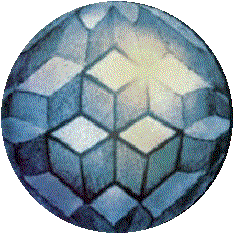|
Conference Papers Online
Keynote Address - as delivered 6/05/98
Netherlands Archives School
International Council on Archives Committee on Information Technology,
chair
Thank you very much for your kind words and for the invitation.
My biggest fear is not the questions that I might get, not even the little
fights but the technology. I donít trust technology at all. Just before
conference it worked, so we take some time to get it working and I will
use even two different types of technology as part of the sound.
My dear colleagues, apart from the great honour there
are a few advantages of being the first speaker of a conference and even
more if one is supposed to deliver the keynote address. One of those advantages
is that no-one can cut the grass under your feet by telling things that
were so essential for your own paper. On the contrary, you are even expected
to make statements for the whole conference and leaving the problems to
answer to that to the speakers who follow. These advantages are so big
that I even donít want to think of the eventual disadvantages of being
the first speaker, such as forgetting issues or not having the opportunity
to react upon previous speakers or not having smelled the atmosphere of
the conference. What will be by paper about? It is about looking at archives
and records from a distant position. It is about abstracting by modeling
and founding archival description on abstract models and actually my paper
will be more than about description. It is a little bit about the application
of archival standards and eventually about seeking global archival concepts.
Concepts that archivists share all over the world instead of stressing
national peculiarities.
Consequently my dear colleagues my paper shall be abstract.
Indeed yesterday we were talking about fun, but Iím afraid will not be
too much fun in this paper. I warn you in advance you can still leave.
I will try to bring together some of the current concepts
of archival description, including the concepts of contents, form, context,
structure and metadata, and I talk about archival constructs as well. Most
of these concepts and key words you will find in the conference program
and no doubt the speakers whose name is related to one of these issues
will explain them way better than I can. I consider my task to be to stay
at a global level and to tell you truth that is where I feel most comfortable.
I will build my paper upon generic data model where Gavan
was referring to and how the ICA committee on information technology, how
is called now, is working, is still working and is proceeding working.
I wonít get into the details of this data model, but it will focus on the
archival theoretical concepts and relaying it.
I must tell you that these concepts are not without discussing
and having debates within the bosom of the information technology committee.
We have sometimes pretty tough fights about it, but usually after that
we take a beer and have fun again. The model in itself was intended to
support the international standard for archival description - ISAD(G) and
basically the ISAD comply in database design and this links my paper to
archival standards.
There is one other thing I should tell you. I came in
Monday night, so yesterday I had the opportunity to meet some people here
in Australia, some other colleagues from abroad, and we talked a little
bit about this conference and this urged me to re-write my paper. So the
original paper is here, and the paper that I read is here, itís in handwriting,
so sometimes when you see me hesitating it is just I cannot decipher my
handwriting though I started my teaching career as a palaeographer, but
that is long ago.
I will get back to that probably later, but first letís
focus a little bit on description. I even was considering to change a little
bit my first slide, but I donít trust the technology too much, but I donít
trust my skills with the technology not at all, so I decided to leave the
title like this.
So I will start with that, what is then archival description?
Why do we describe for? Itís for control. The control of what? The control
of records? The control of objects that contain knowledge? That are the
sources of knowledge? What do we want to control intellectually and physically?
So letís have a look, not to stay too abstracted for the whole paper, a
look in the real world of records, and I should like to have now the video
projector on. That is the other technology. It works. Thanks! I trust people.
click on image to see full-scale version
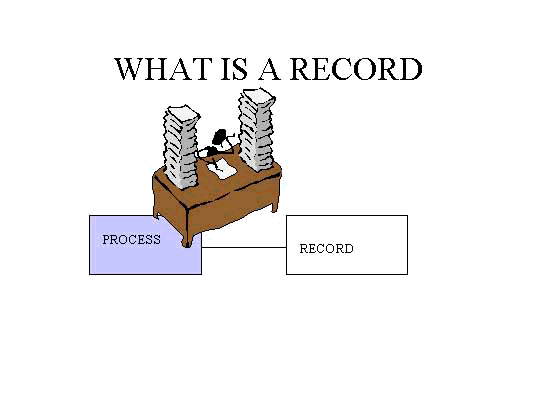
Do we describe as archivists single sheets of paper or
pages in a volume? Now I have to turn. This is really great! Or do we describe
rather volumes as a whole, or series of volumes? I put you a little bit
in the dark, itís just for a while, so donít fall asleep because I will
see you. Do we describe the series of volumes or maybe the whole fonds?
Or is it the context of the records, such as the record creating organisation,
its functions or whatsoever? Or is it finally the context of the records
creator or do we really describe it all? You can switch it off please.
Thanks a lot.
Letís go back to the kernel, to the problem. In 1993 David
Bearman, who else, criticised, what else, the little progress archivists
had made by that time in developing archival automated control systems.
Indeed, he said, the history of archival automation has not been a story
of great successes. Apparently he has never been in the Netherlands before
that time. Or in Australia. Archivists, according to Bearman, were not
able to adequately use the tools of information science. To tell you the
truth, I am not too sure that since 1993 really much progress has been
made, except in Australia of course, and the Netherlands. Sure, since then
much work has been undertaken, and particularly in the field of developing
archival standards to disseminate information, archival information all
over the world. On the international level, the ISAD standard, the international
standard for archival description, followed after a few years by the international
standard for archival authority control for corporate bodies, persons and
families - ISAAR(CPF) - or national standards such as the fabulous Canadian
RAD - the rules for archival description, and all over the world archivists
are breathless trying to adopt again new technologies for controlling records,
inventing new techniques such as encoded archival description, but my dear
colleagues, isnít it old wine in new barrels? Iím afraid it is.
Letís put ourselves the question. Arenít we trying to
catch the tiger by the tail instead of riding the beast? That is an expression
that I borrowed from a Swedish colleague. It is like in 1993, looking at
documentary standards rather than looking at record keeping systems. It
is still basically the thinking of MARC standards rather than working on
real archival description.
Let me try to make my point clear, what itís all about.
I think that the origins of the relative failure so far of archival automation
is in the very fact that archivists take too much a documentary approach.
The starting point for many archivists, except archivists who are sitting
here, the starting point is the records material. Sometimes referred to
with a metaphor of being the sediment of activities. At least in my country
they do it, and they use for the word sediment even the same word that
is used for rain. Something that falls down and thatís unpleasant. Sediment,
is it like polluted mud in a harbour? The dirt of the bureaucracy good
enough only for archivists in the basements of the administration? What
business are we in, to use the words of David Gracy II. Are we in the business
of being refuse collectors? Records my dear colleagues, are not the sediment
of activities. They are the atoms and the evidence of activities, and very
often the only few remains of the activities. They are as dynamic as the
processes that created them, that used them. A sedimentary look pushes
archivists towards a documentary approach. A static view instead of a dynamic
view. The approach of reconstructing an old order, an original order, that
never really existed because it was as dynamic as the organisation that
created and used records and if you want to see an old order, an original
order, please I invite you in my office to have a look at my desk.
A documentary view, a static view, brings us basically
documentary methodologies and techniques, and that is what we see happening
all over the world where archives try to apply the ISAD standards as a
methodology starting with the fonds as a dead collection of used papers
and not with the records, record as the evidence of business transactions.
The whole construct seems to me a library approach. Nothing
wrong with library approach, but itís not an archival approach. Despite
of the fact that many archivists are talking about archival principles
such as the principle of provenance or respect des fonds and we
use wrong terminology, but basically itís too often that library and documentary
approach - this is not a critique, itís just an observation.
What then is a record, what I am talking about? A fonds,
or any kind of grouping of records is fundamentally different from a collection
of documents, and thatís nothing new. Thatís the kernel of archival theory
we have our principles for. But why do archivists neglect this so often
in their description. what we really need is to recognise the dynamic nature
of records. The very bond with the business processes that brought them
into life and that use them. The primary bond is not a bond between the
records, that we will read in the theories of Luciana Duranti for example.
Itís not the bond between them, because by nature documents cannot have
an interrelationship other than by a staple or a paper clip. Neither between
the records and the record creator. It states the fonds concept pretty
much, but the primary bond is the bond between the records and the process,
or the business transaction to use the words of David Bearman again.
The primary provenance is a functional provenance and
not, letís say, a custodial provenance or an organisational provenance.
A record is a record, not by its very nature, because itís just a document,
but because of its function, its role in a business process. Thatís the
basic idea of what we call in these days the functional archival science
as Angelika Menne-Haritz worked it out in paper given at the ICA conference
in Montreal and that she borrowed from Bruno Delmas from France.
The business transaction that creates the record defines
the contents and the form of the record. The contents is the representation
of the act or the fact. The form is dictated by the procedures and the
legislation about the transaction. A simple example if you buy real estate
property you go probably to a lawyer or to a notary, I donít know how itís
here in Australia, but this person is skilled in writing the right things
on the right place in the right form so that it has legal value, so the
act or the fact, thatís the contents of the whole document, and this person
knows in what form to put it ,and itís the same with tax form that you
fill in either by writing it down on paper or do it in electronic format.
This simple sheet two, small boxes and a line, is the
essence of archival science:
click on image to see full-scale version

It is basically the essence, the very kernel of the data
model where Gavan was referring to. Itís not the hierarchical diagram of
the fonds and its component parts that underlies the ISAD thatís the kernel.
The top-down model is too static, itís too rigid. It is an archival construct
that I donít need.
Yet both components, the transaction and the record are
both part of a bigger whole. The transaction is part of a complex system
of functions and organisations. The record is part of another complex system
of files and series and sub series, and all that kind of archival constructs.
Both worlds had their own characteristics, their own rule, their own dynamics
and both worlds should be understood by the archivist of the next one.
click on image to see full-scale version
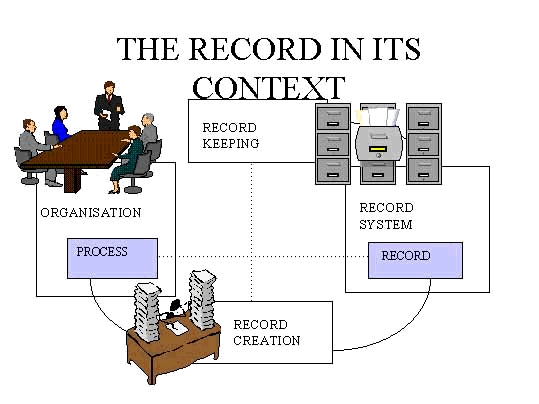
If we want to describe or to control archival objects,
archival knowledge, to control it for whatever purpose we should look at
both worlds separately, but we must understand the relationships at the
very bottom. The relationships and what governs the behaviour of each of
the both worlds.
Record creation has to do with functions/tasks of an organisation.
Record keeping, the other part take care of the orderly availability and
reliability of the records by bringing them together into a record system.
What Duranti terms setting aside. Thatís basically the two functions.
Letís look first at the left hand part of the model, the
world of the business transactions, the functions, and not surprisingly
this part is underdeveloped in the work of archival standards. Some work
in this field on standardisation has been done by the current ICA committee
on archival standards and the ISAAR, though the underlying concept is borrowed
from the library, but, and its rather as a sub alternative to ISAD, rather
than as a separate component of an archival description system, or an archival
control system.
click on image to see full-scale version
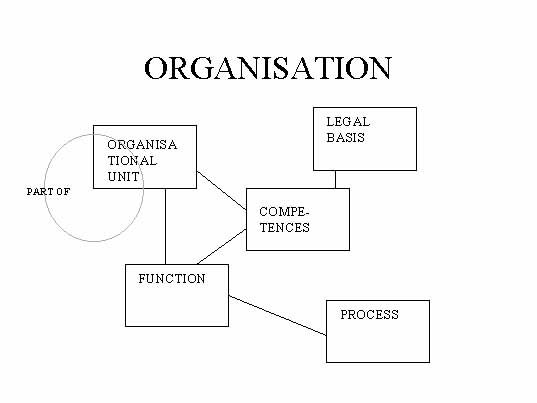
The fundamental entities in this part of an organisation
are the business processes, the transactions, the functions that they carry
out and the organisational structure that is responsible for the operations.
At least for public organisations the relationships between organisations
and their functions are defined by legal system, by law, and this relationship
is called the competence. As one of the few archival institutions that
I know of, the Federal Archives of Switzerland undertook a long lasting
research into the competences of Swiss Federal Agencies since the half
of the 19th century and implemented the results of this research into a
database, the Kompetenz Kartei, and they started working on that
about 10 - 15 years ago on paper and they are transferring it now into
an automated system. When I saw that for the first time, I can tell you
that the Swiss Federal Archives is the most well organised, clean archives
all over the world. You wonít find any piece of paper just hanging around,
its completely organised as the whole country is, except one room, the
room with the Kompetenz Kartei. A classic archive. A more or less
similar approach, a competence based approach, is undertaken by some other
archival institutions including the fellow Archives of Canada and the National
Archives of the Netherlands in the course of appraisal activities. I know
that tomorrow Helen Morgan will say something about it, only nice words.
In the current archival theory this part of the real world
of records is referred to as the context. To be precise the context of
record creating and of the record system. So I turn now contents, to form,
context and archival constructs. So I am pretty far in my paper.
Before going to the right hand side of the model, the
part of the record system, I would like to stand still a moment at the
momentum of the record creation.
click on image to see full-scale version
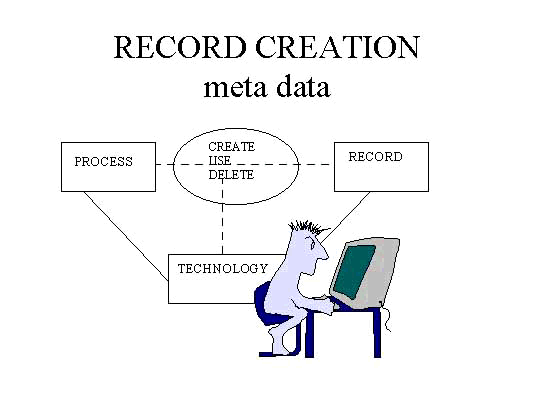
First the momentum itself. The relations between the process
and the records are more complex than just creating a record. The relationships
include also the use and deletion of records. Of course records can only
be created and deleted once, but used an unlimited number of times by various
business processes. Eventually business processes carried out by other
organisations.
It are these relationships, as David Bearman states, that
they should be documented as well, documented by the record keeping system.
It is impossible to do this afterwards, letís say, after disposition or
disposal or whatever you will call it in your terminology. It should be
done by the record system at the very moment of both creation, use and
deletion. In fact any description afterwards is basically due to a defunct
record keeping system, and unfortunately archivists have to deal with a
lot of defunct record keeping systems. One could take the position, however,
that archivists instead of designing description systems should put their
energies into developing record keeping systems. This is particularly true
and promising in our days, in which records become electronic and consequently
record keeping systems need to be redesigned and should have the functionality
of self documenting.
Thatís really going into the forefront of record creation,
and it would not surprise that in the next meeting of the Information Technology
Committee we will talk again about the data model, but then not only use
that data model for archival description, but also as the underlying data
model for record keeping systems, and it would surprise you weíre going
to cooperate, corroborate, with another ICA committee, the committee on
electronic and other current records, who has it in its terms of reference.
Such a record keeping system will then automatically capture
the relevant contextual information and there has been done a lot of research
already what really consist the kernel of the contextual information, its
both the project on the University of British Colombia lead by Luciana
Duranti and also the project at the University of Pittsburgh and currently
also the University of Michigan and other universities are working on that.
The record keeping system shall also automatically capture the data about
the technology used at the momentum of creation and of use and the latter
Iíd like to term metadata. This distinction between context information
and metadata has been advocated by the ICA Committee on Electronic Records
before it was called the committee on electronic and other current records
in its guides for managing electronic records from an archival perspective.
I know that indeed in the world of information science, what Gavan was
referring to, the terms are used sometimes differently. I know, I am an
information engineer, even a knowledge engineer, but who cares, the archival
science is older so we have the first right.
click on image to see full-scale version
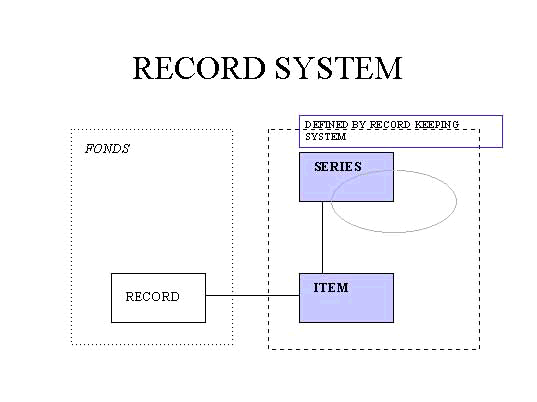
Then finally the record system, the whole of archival constructs
that we call the structure of the fonds. ISAD, as I told before, defines
a simple, rigid hierarchical structure with fonds at the top eventually
with sub fonds underneath and then the series, sub series and so on and
at the bottom line ISAD puts the item, the smallest physical unit to be
produced in the reading room.
I know that the ISAD Committee got a lot of critique particularly
from Australia. I have seen Chris Hurley sitting in the room and we talked
about it in one of the meetings in the Hague on that, and I agree with
the critique on that.
ISAD does not mention the word record, but eventually
defines at that level as the smallest unit the item, letís say a document.
I should like to interchange that for record.
As a matter of fact I donít find the ISAD too much compliant
with current archival thinking. They use the word fonds but what else do
they mean than a record group? By no means ISAD seems to refer to the ideas
and concept as has been laid down over the last years in publications by
Michel Duchein and later by Terry Cook.
Supporting particularly Terry Cook I would define fonds
as a conceptual whole. Of all the records created by an entity, on whatever
level, it is the concept with, I think, no direct practical meaning, although
we have a principle on it. A database terminology, its just a view as a
result of a very simple query such as, select all records created by, and
with a proper database design and proper data input you can define any
forms you want.
The records might be put by the record keeping system
into units, such as folders or volumes. A number of items we might call
a series or a record group. Whatís the essential difference, whatís in
a name.
But my dear colleagues let me look a little bit in our
electronic future. Do we need even the series? I know that what I am going
to tell now is a little bit risky.
A record keeping system, a proper record keeping system,
should mirror the business functions like it does in my model. It should
mirror the business functions and the transaction that created and used
the records. A file, a case file for example, is the whole of records created
and used in the course of one particular set of interrelated business transactions
that you may call a file and it can give a similar definition for a personnel
file.
A series could be a set of files or records created and
used in the course of a business function. Note the series records exist
in that way because in both cases, file and series, the construct could
be realised by simple database views and simple queries in asking for what
function created it, and then we get all the records or what sort of functions
used it. Do we then need the concept of series else than just a term. Isnít
the series, just an archival construct developed for the paper world in
order to establish administrative and intellectual control?
When Peter Scott in 1966 wrote his famous article on abandoning
the record group, didnít he put at the same time a time bomb under his
own series concept? A time bomb that we see bursting in the world of electronic
records?
My dear colleagues, itís really about time not only to
redesign archival description, but the whole of our archival methodologies
and archival constructs. Hopefully, and I do expect this, this conference
will contribute positively to this redesign, and if at the end of this
conference it might come out that I was completely wrong, which I doubt,
but might it come out Iíll be happy to destroy the paper here that I wrote
here and to give this printed one for the proceedings of this conference
and in this little disk is just the opposite of what I have said now. I
thank you. Thank you very much.
(Gavan McCarthy) Iíd just like to thank Peter very
much, for I think its a very challenging and a very revealing presentation.
Early on you mentioned the sediment. Sometime last year I read an article,
probably in New Scientist, about a research project that was run in Melbourne,
I think it is still running in Melbourne in Victoria where I come from,
where they were indeed examining through core analysis the sediments of
the Werribee sewage farm for heavy metals and other pollutants and things
that were passing through people and using this as a way of reconstructing
how life was in 19th century Melbourne. So there are roles for sediments
I think in revealing our past!
|

